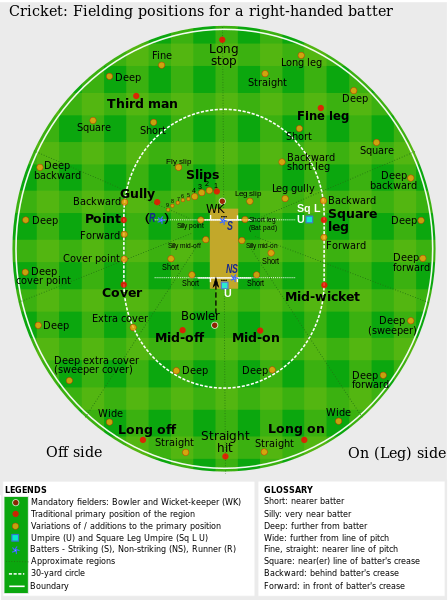Wow I gotta thank LA ICE for those video links. All I had found up to now on google video and youtube was game videos and a Nike commercial. Those videos cleared things up a bit, but, I am embarrassed to say, a "kids" video really helped. "Stumpy and Willow" which seems to have been made by SkySports cleared up alot. There is so much more i'd like to understand, but that video helped. Thanks and I hope I'm not too much of a bother.
Not a problem. To understand fielding a lot better and it's positions:
Of course it would be the opposite if a left hander was batting. Since you have to have a bowler and wicket-keeper you have nine fieldsmen left so the captain has to place his fieldsmen and to try and save runs and get wickets.
To quote wikipedia:
Modifiers
Deep, long
Farther away from the batsman.
Short
Closer to the batsman.
Silly
Very close to the batsman.
Square
Somewhere along an imaginary extension of the popping crease.
Fine
Closer to an extension of an imaginary line along the middle of the pitch bisecting the stumps.
Wide
Further from an extension of an imaginary line along the middle of the pitch bisecting the stumps.
Forward
In front of square; further towards the end occupied by the bowler and further away from the end occupied by the batsman on strike.
Backward
Behind square; further towards the end occupied by the batsman on strike and further away from the end occupied by the bowler.
Additionally, commentators or fans discussing the details of field placement will often use descriptive phrases such as "gully is a bit wider than normal" or "mid off is standing too deep, he should come in shorter".
Laws of cricket
Your not the only one who is posts on here who isn't from a cricket playing country so don't worry (we have two Dutch members, two from Italy, one from Fance, and one from Norway).
A batsman's average is worked out by runs scored and the number of times out, so for example a batsman can score 250 runs, but hasn't been dismissed, so he won't have an average, BUT once he get's out for the first time his average would be 250, get out another 9 times without adding to his run tally, then it would be 25. The higher the average the better. If you see his strike rate, that is the amount of runs scored per 100 balls, so if he scores 70 off 100 then his strike rate would be 70, or likewise if he scores 10 off 20 balls faced, then his strike rate would be 50 and so. Again the higher the better in most cases.
But for bowlers it is the opposite, the wickets taken are counted with the runs conceded. So for example a bowler takes 4/100 (4 wickets for 100 runs) then his average would be 25 or 2/200 then it would be 100 his bowling average, and so on. However, the lower the average the better. His bowling strike rate is calculated against the amount of balls bowled tto take a wicket, and the lower the better. So a bowler takes 1/40 off ten overs, then his average would be 40 and his strike rate would be 60, as on average he is taken one wicket per 60 balls bowled. However, if he took one more wicket, for the same amount of runs and overs, then his average would be 20 and bowling strike rate would be 30 and so on.
You will hear talk of "economy rates" or "runs per over" (same thing) and what they mean is runs calculated against the overs bowled. The lower the better in most circumstances. If 60 runs are conceded off 10, then his economy rate would be 6 runs per over, but if it were 30 runs off 10 overs then it would be 3 runs per over conceded and so on (or bowl 2 overs and concede 10 runs would be 5 per over). A bowler can bowl three overs and concede 20 runs in it, but bowl two more overs and not concede a run (called "maidens") then he would have 5 overs bowled for 20 runs which would give him an economy rate of 4.
For a team fielding the less amount of runs conceded, so lower the run rate (runs per over) is good, but for a team the higher the better as more runs are scored and big scorers are coming quicker.
Anyway, I hope you don't lose track and it doesn't seem so confusing, I have given you a run down in basics of the game in simple ways to follow. If you are looking for a 'Babe Ruth' of the sport then look at
Sir Donald Bradman.



